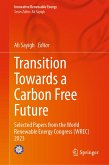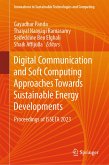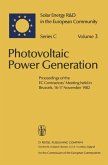Towards Green Hydrogen Generation (eBook, PDF)
Redaktion: Sankir, Mehmet; Sankir, Nurdan Demirci
194,99 €
194,99 €
inkl. MwSt.
Sofort per Download lieferbar

0 °P sammeln
194,99 €
Als Download kaufen

194,99 €
inkl. MwSt.
Sofort per Download lieferbar

0 °P sammeln
Jetzt verschenken
Alle Infos zum eBook verschenken
194,99 €
inkl. MwSt.
Sofort per Download lieferbar
Alle Infos zum eBook verschenken

0 °P sammeln
Towards Green Hydrogen Generation (eBook, PDF)
Redaktion: Sankir, Mehmet; Sankir, Nurdan Demirci
- Format: PDF
- Merkliste
- Auf die Merkliste
- Bewerten Bewerten
- Teilen
- Produkt teilen
- Produkterinnerung
- Produkterinnerung

Bitte loggen Sie sich zunächst in Ihr Kundenkonto ein oder registrieren Sie sich bei
bücher.de, um das eBook-Abo tolino select nutzen zu können.
Hier können Sie sich einloggen
Hier können Sie sich einloggen
Sie sind bereits eingeloggt. Klicken Sie auf 2. tolino select Abo, um fortzufahren.

Bitte loggen Sie sich zunächst in Ihr Kundenkonto ein oder registrieren Sie sich bei bücher.de, um das eBook-Abo tolino select nutzen zu können.
Why is hydrogen so important, you ask? It's a rare gas, after all. Since the COVID-19 pandemic disrupted several areas, hydrogen has fallen into the limelight. Read up on the functions of hydrogen in Towards Green Hydrogen Generation. A variety of issues and multidisciplinary approaches are presented about green hydrogen and related sectors. The book describes a gradual shift in hydrogen production technologies from non-renewable to renewable. As a result, despite the uncertainty created by the pandemic, efforts to build a more sustainable environment have gained momentum.
This volume…mehr
- Geräte: PC
- ohne Kopierschutz
- eBook Hilfe
- Größe: 137.06MB
Andere Kunden interessierten sich auch für
![Design of Green Liquid Dielectrics for Transformers: An Experimental Approach (eBook, PDF) Design of Green Liquid Dielectrics for Transformers: An Experimental Approach (eBook, PDF)]() T. MariprasathDesign of Green Liquid Dielectrics for Transformers: An Experimental Approach (eBook, PDF)102,95 €
T. MariprasathDesign of Green Liquid Dielectrics for Transformers: An Experimental Approach (eBook, PDF)102,95 €![Thermal Comfort in Hot Dry Climates (eBook, PDF) Thermal Comfort in Hot Dry Climates (eBook, PDF)]() Ahmadreza ForuzanmehrThermal Comfort in Hot Dry Climates (eBook, PDF)46,95 €
Ahmadreza ForuzanmehrThermal Comfort in Hot Dry Climates (eBook, PDF)46,95 €![Transition Towards a Carbon Free Future (eBook, PDF) Transition Towards a Carbon Free Future (eBook, PDF)]() Transition Towards a Carbon Free Future (eBook, PDF)121,95 €
Transition Towards a Carbon Free Future (eBook, PDF)121,95 €![Digital Communication and Soft Computing Approaches Towards Sustainable Energy Developments (eBook, PDF) Digital Communication and Soft Computing Approaches Towards Sustainable Energy Developments (eBook, PDF)]() Digital Communication and Soft Computing Approaches Towards Sustainable Energy Developments (eBook, PDF)178,95 €
Digital Communication and Soft Computing Approaches Towards Sustainable Energy Developments (eBook, PDF)178,95 €![Low Energy Cooling for Sustainable Buildings (eBook, PDF) Low Energy Cooling for Sustainable Buildings (eBook, PDF)]() Ursula EickerLow Energy Cooling for Sustainable Buildings (eBook, PDF)77,99 €
Ursula EickerLow Energy Cooling for Sustainable Buildings (eBook, PDF)77,99 €![Solar Electricity Basics - Revised and Updated 2nd Edition (eBook, PDF) Solar Electricity Basics - Revised and Updated 2nd Edition (eBook, PDF)]() Dan ChirasSolar Electricity Basics - Revised and Updated 2nd Edition (eBook, PDF)12,95 €
Dan ChirasSolar Electricity Basics - Revised and Updated 2nd Edition (eBook, PDF)12,95 €![Photovoltaic Power Generation (eBook, PDF) Photovoltaic Power Generation (eBook, PDF)]() Photovoltaic Power Generation (eBook, PDF)40,95 €
Photovoltaic Power Generation (eBook, PDF)40,95 €-
-
-
Why is hydrogen so important, you ask? It's a rare gas, after all. Since the COVID-19 pandemic disrupted several areas, hydrogen has fallen into the limelight. Read up on the functions of hydrogen in Towards Green Hydrogen Generation. A variety of issues and multidisciplinary approaches are presented about green hydrogen and related sectors. The book describes a gradual shift in hydrogen production technologies from non-renewable to renewable. As a result, despite the uncertainty created by the pandemic, efforts to build a more sustainable environment have gained momentum.
This volume covers hydrogen issues by presenting the relationships and opportunities in these related sectors. Organized into three parts, Towards Green Hydrogen Generation introduces and discusses crucial topics on hydrogen. Part 1 is dedicated to the current state and challenges encountered in the industrialization of green hydrogen production. Part 2 recognizes carbon-capturing and hydrogen-related learning models. The last entry introduces green hydrogen generation, PEM water electrolysis, and other electrolyzers.
This volume covers hydrogen issues by presenting the relationships and opportunities in these related sectors. Organized into three parts, Towards Green Hydrogen Generation introduces and discusses crucial topics on hydrogen. Part 1 is dedicated to the current state and challenges encountered in the industrialization of green hydrogen production. Part 2 recognizes carbon-capturing and hydrogen-related learning models. The last entry introduces green hydrogen generation, PEM water electrolysis, and other electrolyzers.
Dieser Download kann aus rechtlichen Gründen nur mit Rechnungsadresse in D ausgeliefert werden.
Produktdetails
- Produktdetails
- Verlag: John Wiley & Sons
- Seitenzahl: 486
- Erscheinungstermin: 14. August 2024
- Englisch
- ISBN-13: 9781394234103
- Artikelnr.: 72556231
- Verlag: John Wiley & Sons
- Seitenzahl: 486
- Erscheinungstermin: 14. August 2024
- Englisch
- ISBN-13: 9781394234103
- Artikelnr.: 72556231
- Herstellerkennzeichnung Die Herstellerinformationen sind derzeit nicht verfügbar.
Mehmet Sankir, PhD, received his doctorate in macromolecular science and engineering from the Virginia Polytechnic and State University, USA, in 2005. Dr. Sankir is a full professor in the Department of Materials Science and Nanotechnology Engineering, TOBB University of Economics and Technology, Ankara, Turkey, and group leader of the Advanced Membrane Technologies Laboratory. He has carried out research and consulting activities in the areas of membranes for fuel cells, flow batteries, hydrogen generation, and desalination. He has organized special sessions for engineering conferences. This is his seventh co-edited book with the Wiley-Scrivener imprint. Nurdan Demirci Sankir, PhD, is a full professor in the Materials Science and Nanotechnology Engineering Department at the TOBB University of Economics and Technology (TOBB ETU), Ankara, Turkey. She received her doctorate degree in materials science and engineering from the Virginia Polytechnic and State University, USA, in 2005. After graduation, she joined NanoSonic Inc. in Virginia, USA as an R&D engineer and program manager. In 2007, she enrolled at TOBB ETU, where she has been a faculty member since then. She established the Energy Research and Solar Cell Laboratories at TOBB ETU. Nurdan has actively carried out research and consulting activities in the areas of photovoltaic devices, solution-based thin-film manufacturing, solar-driven water splitting, photocatalytic degradation, and nanostructured semiconductors. This is her seventh co-edited book with the Wiley-Scrivener imprint.
Preface xiii
Part 1: Hydrogen and the Green Deal 1
1 Decarbonizing the Industry with Green Hydrogen 3
Cigdem Tuc Altaf, Orcun Demir, Tuluhan Olcayto Colak, Emine Karagöz, Mehmet
Kurt, Nurdan Demirci Sankir and Mehmet Sankir
1.1 Introduction 4
1.2 Intersections of National H2 Strategies 6
1.3 Decarbonization of Carbon-Intensive Sectors 9
1.4 Developments in Industrial Use of Green H2 19
1.5 Conclusions 35
2 Conventional to Renewable Hydrogen Production: A Paradigm Shift Toward
Sustainable Energy 49
Kriti Shrivasava and Ankur Jain
2.1 Introduction 50
2.2 Hydrogen Production Technologies 52
2.3 Production of Blue Hydrogen 54
3 Toward Green Hydrogen Generation 87
Kexin Yin, Yinglong Wang, Xiaoying Zhang, Yusen Chen and Jianhui Zhong
3.1 Introduction 88
3.2 Traditional Hydrogen Production Technology 91
3.3 Green Hydrogen Production Technology 95
3.4 Challenges Facing the Industrialization of Green Hydrogen Production
112
3.5 Conclusion 114
Part 2: Carbon Capturing and Hydrogen 121
4 Biomass Waste-to-Hydrogen Conversion: Innovations in Methanol and Ammonia
Production as Efficient and Sustainable Hydrogen Storage Pathways 123
Arif Darmawan, Abdul Hadi, Abdul Hamid Budiman, Eniya Listiani Dewi and
Muhammad Aziz
4.1 Introduction 124
4.2 Hydrogen Production from Thermochemical Conversion and Methanol/Ammonia
as Potential Hydrogen Carriers 126
4.3 Enhancing Efficiency through Process Modeling and Exergy Optimization
129
4.4 Municipal Solid Waste Conversion to Hydrogen and Methanol for Efficient
Energy Storage 136
4.5 Innovations in Direct Ammonia Production from Biomass Waste through
Carbonization and Thermochemical Cycles 138
4.6 Exergoeconomic Analysis, Combining Techno-Economic Analysis, and Exergy
Analysis 141
4.7 Conclusion 144
5 Advances and Challenges in Metal Oxide--Based Carbon Capture
Technologies: An Overview 149
Berfu Kocabas, Olgu C. Cosar, Arpad Mihai Rostas, Ipek Deniz Yildirim,
Ahmet Gungor and Emre Erdem
5.1 Introduction 149
5.2 Metal Oxides as Carbon Capture Agents 152
5.3 Enhancing Carbon Capture Efficiency 154
5.4 Future Trends and Research Directions 165
5.5 Conclusion 166
6 Coupling of Process Intensification to Life Cycle Assessment for
Eco-Design of Biohydrogen Factory by Microalgae 171
Iván Ehecatl López-González, Pablo Antonio López-Pérez and Dulce Jazmín
Hernández-Melchor
6.1 Introduction 172
6.2 Methodology 181
6.3 Numerical Experiments 187
6.4 Conclusion 193
7 In Situ Monitoring for Biohydrogen Production Using a Low-Cost Sensor 205
Pablo Antonio López Pérez, Patricia Meneses Martínez, Emmanuel Vallejo
Castañeda and Ricardo Aguilar López
7.1 Introduction 206
7.2 Methodology 219
7.3 Results 225
7.4 Conclusions 231
Part 3: Green Hydrogen Generation 237
8 Green Hydrogen Production by PEM Water Electrolysis 239
Sergey A. Grigoriev
9 Wind Driven Hydrogen Production in Eastern Morocco: Suitability Atlas
Development and Techno-Economic Analysis 267
Salaheddine Amrani, Samir Touili, Abdellatif Azzaoui, Ahmed Alami Merrouni
and Hassane Dekhissi
9.1 Introduction 268
9.2 Materials and Methods 269
9.3 Results and Discussion 282
9.4 Conclusion 288
10 Bifunctional Electrocatalyst--Driven Hybrid Water Splitting for
Energy-Saving Coproduction of Green H2 and ValuableChemicals 293
Hui Jiang, Guoliang Mei and Bo You
10.1 Introduction 294
10.2 Fundamentals of Hybrid Water Splitting 296
10.3 Electrochemical Reconstruction 303
10.4 Hybrid Water Splitting with Oxidative Upgrading 306
10.5 Conclusions and Outlook 334
11 Electrolyzers for H2 Production: A Review 359
Edisson Villa-Ávila, Paul Arévalo, Marcos Tostado-Véliz and Francisco
Jurado
11.1 Introduction 360
11.2 Materials and Methods 362
11.3 Advances in Electrolyzer Technology 371
11.4 Future Perspectives and Trends 377
11.5 Current Challenges and Obstacles 382
11.6 Applications and Industrial Potential 383
11.7 Case Studies 385
11.8 Economic and Sustainability Considerations 387
11.9 Conclusions and Recommendations 394
12 Green Hydrogen Generation by Water Electrolysis 407
Weizhe Zhang, Yixiang Shi, Shuang Li and Ningsheng Cai
12.1 Introduction 408
12.2 Fundamentals of Water Electrolysis 408
12.3 Alkaline Electrolysis Cell (AEC) 414
12.4 Polymer Electrolyte Membrane Electrolysis Cell (PEMEC) 422
12.5 Protonic Ceramic Electrolysis Cell (PCEC) 429
12.6 Solid Oxide Electrolysis Cell (SOEC) 435
12.7 Summary 440
References 441
Index 463
Part 1: Hydrogen and the Green Deal 1
1 Decarbonizing the Industry with Green Hydrogen 3
Cigdem Tuc Altaf, Orcun Demir, Tuluhan Olcayto Colak, Emine Karagöz, Mehmet
Kurt, Nurdan Demirci Sankir and Mehmet Sankir
1.1 Introduction 4
1.2 Intersections of National H2 Strategies 6
1.3 Decarbonization of Carbon-Intensive Sectors 9
1.4 Developments in Industrial Use of Green H2 19
1.5 Conclusions 35
2 Conventional to Renewable Hydrogen Production: A Paradigm Shift Toward
Sustainable Energy 49
Kriti Shrivasava and Ankur Jain
2.1 Introduction 50
2.2 Hydrogen Production Technologies 52
2.3 Production of Blue Hydrogen 54
3 Toward Green Hydrogen Generation 87
Kexin Yin, Yinglong Wang, Xiaoying Zhang, Yusen Chen and Jianhui Zhong
3.1 Introduction 88
3.2 Traditional Hydrogen Production Technology 91
3.3 Green Hydrogen Production Technology 95
3.4 Challenges Facing the Industrialization of Green Hydrogen Production
112
3.5 Conclusion 114
Part 2: Carbon Capturing and Hydrogen 121
4 Biomass Waste-to-Hydrogen Conversion: Innovations in Methanol and Ammonia
Production as Efficient and Sustainable Hydrogen Storage Pathways 123
Arif Darmawan, Abdul Hadi, Abdul Hamid Budiman, Eniya Listiani Dewi and
Muhammad Aziz
4.1 Introduction 124
4.2 Hydrogen Production from Thermochemical Conversion and Methanol/Ammonia
as Potential Hydrogen Carriers 126
4.3 Enhancing Efficiency through Process Modeling and Exergy Optimization
129
4.4 Municipal Solid Waste Conversion to Hydrogen and Methanol for Efficient
Energy Storage 136
4.5 Innovations in Direct Ammonia Production from Biomass Waste through
Carbonization and Thermochemical Cycles 138
4.6 Exergoeconomic Analysis, Combining Techno-Economic Analysis, and Exergy
Analysis 141
4.7 Conclusion 144
5 Advances and Challenges in Metal Oxide--Based Carbon Capture
Technologies: An Overview 149
Berfu Kocabas, Olgu C. Cosar, Arpad Mihai Rostas, Ipek Deniz Yildirim,
Ahmet Gungor and Emre Erdem
5.1 Introduction 149
5.2 Metal Oxides as Carbon Capture Agents 152
5.3 Enhancing Carbon Capture Efficiency 154
5.4 Future Trends and Research Directions 165
5.5 Conclusion 166
6 Coupling of Process Intensification to Life Cycle Assessment for
Eco-Design of Biohydrogen Factory by Microalgae 171
Iván Ehecatl López-González, Pablo Antonio López-Pérez and Dulce Jazmín
Hernández-Melchor
6.1 Introduction 172
6.2 Methodology 181
6.3 Numerical Experiments 187
6.4 Conclusion 193
7 In Situ Monitoring for Biohydrogen Production Using a Low-Cost Sensor 205
Pablo Antonio López Pérez, Patricia Meneses Martínez, Emmanuel Vallejo
Castañeda and Ricardo Aguilar López
7.1 Introduction 206
7.2 Methodology 219
7.3 Results 225
7.4 Conclusions 231
Part 3: Green Hydrogen Generation 237
8 Green Hydrogen Production by PEM Water Electrolysis 239
Sergey A. Grigoriev
9 Wind Driven Hydrogen Production in Eastern Morocco: Suitability Atlas
Development and Techno-Economic Analysis 267
Salaheddine Amrani, Samir Touili, Abdellatif Azzaoui, Ahmed Alami Merrouni
and Hassane Dekhissi
9.1 Introduction 268
9.2 Materials and Methods 269
9.3 Results and Discussion 282
9.4 Conclusion 288
10 Bifunctional Electrocatalyst--Driven Hybrid Water Splitting for
Energy-Saving Coproduction of Green H2 and ValuableChemicals 293
Hui Jiang, Guoliang Mei and Bo You
10.1 Introduction 294
10.2 Fundamentals of Hybrid Water Splitting 296
10.3 Electrochemical Reconstruction 303
10.4 Hybrid Water Splitting with Oxidative Upgrading 306
10.5 Conclusions and Outlook 334
11 Electrolyzers for H2 Production: A Review 359
Edisson Villa-Ávila, Paul Arévalo, Marcos Tostado-Véliz and Francisco
Jurado
11.1 Introduction 360
11.2 Materials and Methods 362
11.3 Advances in Electrolyzer Technology 371
11.4 Future Perspectives and Trends 377
11.5 Current Challenges and Obstacles 382
11.6 Applications and Industrial Potential 383
11.7 Case Studies 385
11.8 Economic and Sustainability Considerations 387
11.9 Conclusions and Recommendations 394
12 Green Hydrogen Generation by Water Electrolysis 407
Weizhe Zhang, Yixiang Shi, Shuang Li and Ningsheng Cai
12.1 Introduction 408
12.2 Fundamentals of Water Electrolysis 408
12.3 Alkaline Electrolysis Cell (AEC) 414
12.4 Polymer Electrolyte Membrane Electrolysis Cell (PEMEC) 422
12.5 Protonic Ceramic Electrolysis Cell (PCEC) 429
12.6 Solid Oxide Electrolysis Cell (SOEC) 435
12.7 Summary 440
References 441
Index 463
Preface xiii
Part 1: Hydrogen and the Green Deal 1
1 Decarbonizing the Industry with Green Hydrogen 3
Cigdem Tuc Altaf, Orcun Demir, Tuluhan Olcayto Colak, Emine Karagöz, Mehmet
Kurt, Nurdan Demirci Sankir and Mehmet Sankir
1.1 Introduction 4
1.2 Intersections of National H2 Strategies 6
1.3 Decarbonization of Carbon-Intensive Sectors 9
1.4 Developments in Industrial Use of Green H2 19
1.5 Conclusions 35
2 Conventional to Renewable Hydrogen Production: A Paradigm Shift Toward
Sustainable Energy 49
Kriti Shrivasava and Ankur Jain
2.1 Introduction 50
2.2 Hydrogen Production Technologies 52
2.3 Production of Blue Hydrogen 54
3 Toward Green Hydrogen Generation 87
Kexin Yin, Yinglong Wang, Xiaoying Zhang, Yusen Chen and Jianhui Zhong
3.1 Introduction 88
3.2 Traditional Hydrogen Production Technology 91
3.3 Green Hydrogen Production Technology 95
3.4 Challenges Facing the Industrialization of Green Hydrogen Production
112
3.5 Conclusion 114
Part 2: Carbon Capturing and Hydrogen 121
4 Biomass Waste-to-Hydrogen Conversion: Innovations in Methanol and Ammonia
Production as Efficient and Sustainable Hydrogen Storage Pathways 123
Arif Darmawan, Abdul Hadi, Abdul Hamid Budiman, Eniya Listiani Dewi and
Muhammad Aziz
4.1 Introduction 124
4.2 Hydrogen Production from Thermochemical Conversion and Methanol/Ammonia
as Potential Hydrogen Carriers 126
4.3 Enhancing Efficiency through Process Modeling and Exergy Optimization
129
4.4 Municipal Solid Waste Conversion to Hydrogen and Methanol for Efficient
Energy Storage 136
4.5 Innovations in Direct Ammonia Production from Biomass Waste through
Carbonization and Thermochemical Cycles 138
4.6 Exergoeconomic Analysis, Combining Techno-Economic Analysis, and Exergy
Analysis 141
4.7 Conclusion 144
5 Advances and Challenges in Metal Oxide--Based Carbon Capture
Technologies: An Overview 149
Berfu Kocabas, Olgu C. Cosar, Arpad Mihai Rostas, Ipek Deniz Yildirim,
Ahmet Gungor and Emre Erdem
5.1 Introduction 149
5.2 Metal Oxides as Carbon Capture Agents 152
5.3 Enhancing Carbon Capture Efficiency 154
5.4 Future Trends and Research Directions 165
5.5 Conclusion 166
6 Coupling of Process Intensification to Life Cycle Assessment for
Eco-Design of Biohydrogen Factory by Microalgae 171
Iván Ehecatl López-González, Pablo Antonio López-Pérez and Dulce Jazmín
Hernández-Melchor
6.1 Introduction 172
6.2 Methodology 181
6.3 Numerical Experiments 187
6.4 Conclusion 193
7 In Situ Monitoring for Biohydrogen Production Using a Low-Cost Sensor 205
Pablo Antonio López Pérez, Patricia Meneses Martínez, Emmanuel Vallejo
Castañeda and Ricardo Aguilar López
7.1 Introduction 206
7.2 Methodology 219
7.3 Results 225
7.4 Conclusions 231
Part 3: Green Hydrogen Generation 237
8 Green Hydrogen Production by PEM Water Electrolysis 239
Sergey A. Grigoriev
9 Wind Driven Hydrogen Production in Eastern Morocco: Suitability Atlas
Development and Techno-Economic Analysis 267
Salaheddine Amrani, Samir Touili, Abdellatif Azzaoui, Ahmed Alami Merrouni
and Hassane Dekhissi
9.1 Introduction 268
9.2 Materials and Methods 269
9.3 Results and Discussion 282
9.4 Conclusion 288
10 Bifunctional Electrocatalyst--Driven Hybrid Water Splitting for
Energy-Saving Coproduction of Green H2 and ValuableChemicals 293
Hui Jiang, Guoliang Mei and Bo You
10.1 Introduction 294
10.2 Fundamentals of Hybrid Water Splitting 296
10.3 Electrochemical Reconstruction 303
10.4 Hybrid Water Splitting with Oxidative Upgrading 306
10.5 Conclusions and Outlook 334
11 Electrolyzers for H2 Production: A Review 359
Edisson Villa-Ávila, Paul Arévalo, Marcos Tostado-Véliz and Francisco
Jurado
11.1 Introduction 360
11.2 Materials and Methods 362
11.3 Advances in Electrolyzer Technology 371
11.4 Future Perspectives and Trends 377
11.5 Current Challenges and Obstacles 382
11.6 Applications and Industrial Potential 383
11.7 Case Studies 385
11.8 Economic and Sustainability Considerations 387
11.9 Conclusions and Recommendations 394
12 Green Hydrogen Generation by Water Electrolysis 407
Weizhe Zhang, Yixiang Shi, Shuang Li and Ningsheng Cai
12.1 Introduction 408
12.2 Fundamentals of Water Electrolysis 408
12.3 Alkaline Electrolysis Cell (AEC) 414
12.4 Polymer Electrolyte Membrane Electrolysis Cell (PEMEC) 422
12.5 Protonic Ceramic Electrolysis Cell (PCEC) 429
12.6 Solid Oxide Electrolysis Cell (SOEC) 435
12.7 Summary 440
References 441
Index 463
Part 1: Hydrogen and the Green Deal 1
1 Decarbonizing the Industry with Green Hydrogen 3
Cigdem Tuc Altaf, Orcun Demir, Tuluhan Olcayto Colak, Emine Karagöz, Mehmet
Kurt, Nurdan Demirci Sankir and Mehmet Sankir
1.1 Introduction 4
1.2 Intersections of National H2 Strategies 6
1.3 Decarbonization of Carbon-Intensive Sectors 9
1.4 Developments in Industrial Use of Green H2 19
1.5 Conclusions 35
2 Conventional to Renewable Hydrogen Production: A Paradigm Shift Toward
Sustainable Energy 49
Kriti Shrivasava and Ankur Jain
2.1 Introduction 50
2.2 Hydrogen Production Technologies 52
2.3 Production of Blue Hydrogen 54
3 Toward Green Hydrogen Generation 87
Kexin Yin, Yinglong Wang, Xiaoying Zhang, Yusen Chen and Jianhui Zhong
3.1 Introduction 88
3.2 Traditional Hydrogen Production Technology 91
3.3 Green Hydrogen Production Technology 95
3.4 Challenges Facing the Industrialization of Green Hydrogen Production
112
3.5 Conclusion 114
Part 2: Carbon Capturing and Hydrogen 121
4 Biomass Waste-to-Hydrogen Conversion: Innovations in Methanol and Ammonia
Production as Efficient and Sustainable Hydrogen Storage Pathways 123
Arif Darmawan, Abdul Hadi, Abdul Hamid Budiman, Eniya Listiani Dewi and
Muhammad Aziz
4.1 Introduction 124
4.2 Hydrogen Production from Thermochemical Conversion and Methanol/Ammonia
as Potential Hydrogen Carriers 126
4.3 Enhancing Efficiency through Process Modeling and Exergy Optimization
129
4.4 Municipal Solid Waste Conversion to Hydrogen and Methanol for Efficient
Energy Storage 136
4.5 Innovations in Direct Ammonia Production from Biomass Waste through
Carbonization and Thermochemical Cycles 138
4.6 Exergoeconomic Analysis, Combining Techno-Economic Analysis, and Exergy
Analysis 141
4.7 Conclusion 144
5 Advances and Challenges in Metal Oxide--Based Carbon Capture
Technologies: An Overview 149
Berfu Kocabas, Olgu C. Cosar, Arpad Mihai Rostas, Ipek Deniz Yildirim,
Ahmet Gungor and Emre Erdem
5.1 Introduction 149
5.2 Metal Oxides as Carbon Capture Agents 152
5.3 Enhancing Carbon Capture Efficiency 154
5.4 Future Trends and Research Directions 165
5.5 Conclusion 166
6 Coupling of Process Intensification to Life Cycle Assessment for
Eco-Design of Biohydrogen Factory by Microalgae 171
Iván Ehecatl López-González, Pablo Antonio López-Pérez and Dulce Jazmín
Hernández-Melchor
6.1 Introduction 172
6.2 Methodology 181
6.3 Numerical Experiments 187
6.4 Conclusion 193
7 In Situ Monitoring for Biohydrogen Production Using a Low-Cost Sensor 205
Pablo Antonio López Pérez, Patricia Meneses Martínez, Emmanuel Vallejo
Castañeda and Ricardo Aguilar López
7.1 Introduction 206
7.2 Methodology 219
7.3 Results 225
7.4 Conclusions 231
Part 3: Green Hydrogen Generation 237
8 Green Hydrogen Production by PEM Water Electrolysis 239
Sergey A. Grigoriev
9 Wind Driven Hydrogen Production in Eastern Morocco: Suitability Atlas
Development and Techno-Economic Analysis 267
Salaheddine Amrani, Samir Touili, Abdellatif Azzaoui, Ahmed Alami Merrouni
and Hassane Dekhissi
9.1 Introduction 268
9.2 Materials and Methods 269
9.3 Results and Discussion 282
9.4 Conclusion 288
10 Bifunctional Electrocatalyst--Driven Hybrid Water Splitting for
Energy-Saving Coproduction of Green H2 and ValuableChemicals 293
Hui Jiang, Guoliang Mei and Bo You
10.1 Introduction 294
10.2 Fundamentals of Hybrid Water Splitting 296
10.3 Electrochemical Reconstruction 303
10.4 Hybrid Water Splitting with Oxidative Upgrading 306
10.5 Conclusions and Outlook 334
11 Electrolyzers for H2 Production: A Review 359
Edisson Villa-Ávila, Paul Arévalo, Marcos Tostado-Véliz and Francisco
Jurado
11.1 Introduction 360
11.2 Materials and Methods 362
11.3 Advances in Electrolyzer Technology 371
11.4 Future Perspectives and Trends 377
11.5 Current Challenges and Obstacles 382
11.6 Applications and Industrial Potential 383
11.7 Case Studies 385
11.8 Economic and Sustainability Considerations 387
11.9 Conclusions and Recommendations 394
12 Green Hydrogen Generation by Water Electrolysis 407
Weizhe Zhang, Yixiang Shi, Shuang Li and Ningsheng Cai
12.1 Introduction 408
12.2 Fundamentals of Water Electrolysis 408
12.3 Alkaline Electrolysis Cell (AEC) 414
12.4 Polymer Electrolyte Membrane Electrolysis Cell (PEMEC) 422
12.5 Protonic Ceramic Electrolysis Cell (PCEC) 429
12.6 Solid Oxide Electrolysis Cell (SOEC) 435
12.7 Summary 440
References 441
Index 463







